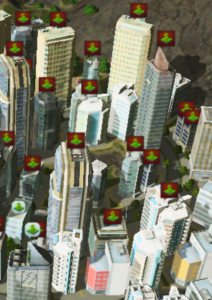

It’s interesting that the American SimCity series placed this importance on wealth as an independent variable that allowed for the development of large poor districts or high rise tenements, whereas Finnish Skylines doesn’t treat this as a large issue. Previous games, including the most recent SimCity, have separated wealth and demand, so you could have a huge demand for affordable housing but very little demand for mansion blocks, which translated into much more complex interaction between classes. Skylines only simulates housing demand as one demand, rather than simulating separate demand for affordable and luxury housing. It makes sense from a development perspective and, in a game, is probably entirely fair, but it’s interesting that both SimCity (2013) and Skylines moved away from representing chronological progression and present contemporary architecture as the only form a city ever takes. It’s another top down approach which really denies individuality to cities at the most zoomed in levels. Every building is always up for upgrading should conditions change - there’s no simulated World Heritage Committee or Athens Charter here. Not only are the traditional styles of architecture present in some games of the SimCity series absent, but there’s no option to preserve buildings either. Again, that’s probably down to developer limitations, but every building is at least contemporary in style, with no concessions to 19th or 20th century ideas of what cities should look like (with the exception of some industry, which goes for a cheerfully Dickensian smokestack look). Interestingly, the game doesn’t really do heritage. Part of the fun of the game is the puzzle of finding a good traffic solution, but it also demonstrates a classic urban planning view of top down cities - where the layout is king and the buildings are filler.Ģ. Clearly it would be extremely difficult to increase the art team’s workload by demanding the inclusion of several different styles of architecture, but the non-committal architecture coupled with an ever-so-slightly bland color palette places the focus on transport networks rather than the buildings themselves. Although the prolific modding community is rapidly stuffing the game with representations of landmarks and monuments, and plans are afoot to bring European style, wall to wall buildings into the game, the fact that the release version of Skylines tries to avoid evoking any individual style leaves it feeling a little like nowhere at all. But Skylines does the exact opposite: every building is a generic idea of what a shop or an office would look like. Other city-building games have taken direct inspiration from real buildings, with the SimCity series cheerfully cribbing and renaming buildings local to the development team, as well as including intentional replicas of famous landmarks. Save this picture! The focus on layout resembles classic urban planning models. There is a top down focus on layout, not the buildings

We investigate 10 things this game tells us about 21st century urbanism, after the break.ġ. The limitations around designing a video game - the fact that each asset must be modeled and textured, and that each transport option requires a huge amount of work to simulate - mean that Cities: Skylines is as stripped down and streamlined an articulation of urban philosophy as Le Corbusier’s Ville Radieuse or the New Urbanists' models, and just as interesting. But simulations require assumptions they are, after all, written by people who have their own conscious and unconscious views on how and why cities work. Following what is widely considered as a disappointing SimCity reboot in 2013, Finland’s Colossal Order recently released Cities: Skylines to critical and financial success. Sim games became the subject of academic critiques of their philosophy of the world, while city builders became a lot more than a game: in 2002, SimCity 3000 was used as a semi-serious test for mayoral candidates in Warsaw.Īfter a slump caused by a difficult transition to 3D graphics, city builders are back in vogue. The huge success of the “Sim” series in general drove conversations about the value of simulation, as part of the general 1990s optimism about virtual worlds being the future. Ask a random person in the street about their favorite hobbies, and it’s unlikely that they’ll say “ urban planning and traffic management” - yet when video games began to take off in the late 1980s city-building was one of the first breakout hits, in the form of Maxis’ SimCity series.


 0 kommentar(er)
0 kommentar(er)
